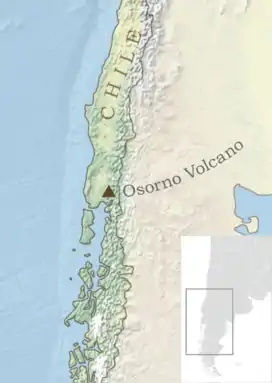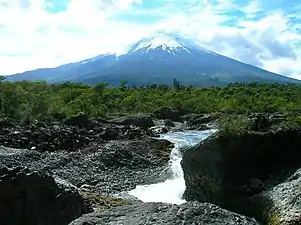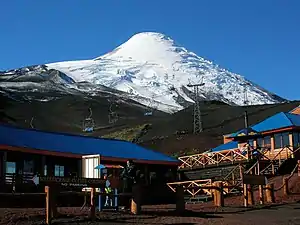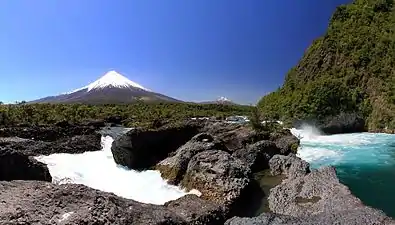| Osorno | |
|---|---|
 Osorno Volcano and Llanquihue Lake | |
| Highest point | |
| Elevation | 2,652 m (8,701 ft)[1] |
| Coordinates | 41°06′17″S 72°29′46″W / 41.10472°S 72.49611°W |
| Geography | |

| |
| Location | Chile |
| Parent range | Andes |
| Geology | |
| Mountain type | Stratovolcano |
| Volcanic arc/belt | South Volcanic Zone |
| Last eruption | 1869[1] |
| Climbing | |
| First ascent | 1848 by Jean Renous |
| Easiest route | rock/snow/ice climb |
Osorno Volcano is a 2,652-metre-tall (8,701 ft) conical stratovolcano lying between Osorno Province and Llanquihue Province in the Los Lagos Region of southern Chile. It stands on the southeastern shore of Llanquihue Lake, and also towers over Todos los Santos Lake. Osorno is considered a symbol of the local landscape and, as such, tends to be the referential element of the area in regards to tourism. By some definitions, it marks the northern boundary of Chilean Patagonia.
Etymology
The volcano's current name comes from the nearby city of Osorno, from which it was visible to Spanish settlers. Native populations gave it different names, such as Purailla, Purarhue, Prarauque, Peripillan, Choshueco, Hueñauca, and Guanauca. The latter two were the most commonly used names in the mid-18th century.[2][3]
Overview
The volcano has a height of 2,652 meters (8,701 feet) and an imposing conical shape which looms over Lago Llanquihue. It is situated across the lake from the cities of Frutillar, Puerto Varas, and Llanquehue. It dominates the region's landscape, and its height means that it can be seen from the entire province of Osorno, even in some places on the island of Chiloé. Volcán Osorno is located almost 45 kilometers (28 miles) northeast of Puerto Varas. Though in geological terms it is still considered an active volcano, there has been no volcanic activity in over one hundred years, having last erupted in 1869. In recent years the volcano has become a popular tourist attraction. Skiing and hiking have become common recreational activities on the mountain.[4]
The volcano is accessible from the towns of Puerto Klocker, Ensenada, and Petrohué, and at its base is the town of Las Cascadas.
Volcanic activity
Volcán Osorno is one of the most active volcanoes of the southern Chilean Andes, with eleven eruptions recorded between 1575 and 1869. It sits on top of a 250,000-year-old eroded stratovolcano, La Picada, with a 6-km-wide caldera.[5][6]
On January 19, 1835, during the second voyage of the Beagle, Charles Darwin was near Ancud and witnessed an eruption of the volcano, which he recorded in his journal and which made him suspect the existence of a relationship between the simultaneous activity of geographically distant volcanoes.[7] However, the data on which this idea was based were, at least in part, wrong, since they reported an eruption of Aconcagua, which is very unlikely given that even in Darwin's time, Aconcagua was already a long-extinct paleovolcano.[4][8]
Appearance
The basalt and andesite lava flows generated during these eruptions reached both Lago Llanquihue and Lago Todos Los Santos. The upper slopes of the volcano are almost entirely covered in glaciers despite its very modest altitude and latitude, sustained by the substantial annual snowfall in the very moist maritime climate of the region. Osorno has also historically produced pyroclastic flow, since it is a composite volcano.[9] The volcano has been noted for its similar appearance to Mount Fuji in Japan.[10][11]
Image gallery
|
See also
References
- 1 2 "Osorno". Global Volcanism Program. Smithsonian Institution. Retrieved 2010-05-06.
- ↑ Kinzel, E.; Klenner, H. (1985). Puerto Varas: 130 años de historia, 1852-1983 (in Spanish). p. 409. LCCN 85198482.
- ↑ Steffen, H (1936). Contribución a la historia del descubrimiento y exploración de las cordilleras sudamericanas (in Spanish). pp. 88–186.
- 1 2 "Sierra magazine, Jan/Feb 2006, travel column, "Good Going"". Archived from the original on 2017-07-05. Retrieved 2006-02-02.
- ↑ "Volcanoes of South America". Global Volcanism Program. Smithsonian Institution. Retrieved 2010-02-23.
- ↑ "Servicio Nacional de Geografía y Minería: Volcán Osorno". Archived from the original on 22 February 2018. Retrieved 14 November 2022.
- ↑ "Darwin's earthquakes". Darwin Correspondence Project. 2016-01-18. Retrieved 2022-03-04.
- ↑ "The American Museum of Natural History: A Trip Around the World". Archived from the original on 2006-01-28. Retrieved 2006-02-02.
- ↑ "Ranking de Riesgo de Específico de Volcanes Activos" [Risk rank of active volcanoes] (PDF) (in Spanish). 20 February 2020. Retrieved 14 November 2022.
- ↑ "Osorno Volcano, Chile". www.patagonia-calling.com. Retrieved 2022-03-01.
- ↑ "Osorno Volcano |". Alluring World. 2017-08-16. Retrieved 2022-03-01.
Further reading
- Biggar, John (2005). The Andes: A Guide for Climbers (3rd ed.). Andes Publishing (Scotland). p. 304 pp. ISBN 0-9536087-2-7.
- González-Ferrán, Oscar (1995). Volcanes de Chile. Santiago, Chile: Instituto Geográfico Militar. p. 640 pp. ISBN 956-202-054-1. (in Spanish; also includes volcanoes of Argentina, Bolivia, and Peru)







